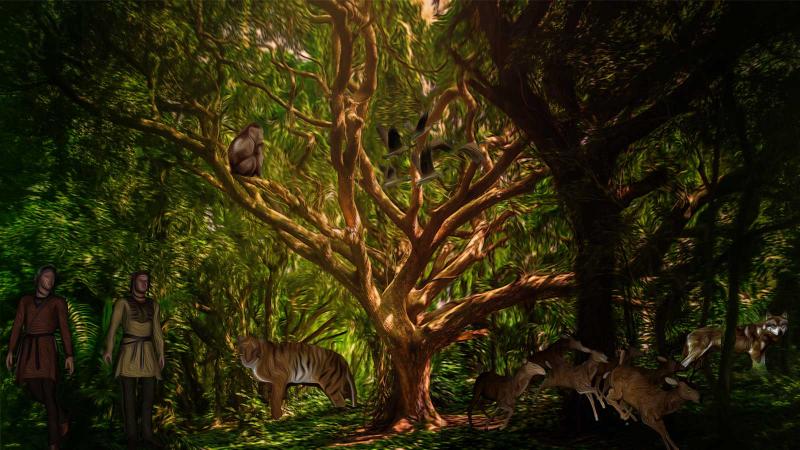
In the last few decades, governments and people across the world have made efforts to conserve biodiversity. To this effect, in India, according to the Wild Life Protection Act 1972, national parks, wildlife sanctuaries, conservation reserves, and community reserves are earmarked as ‘protected areas’. A 2006 estimate by the Ministry of Environment and Forests put the number of Indian citizens dependent on forests for their lives and livelihoods between 200 to 400 million, spread across about 173,000 villages. A 2009 report noted 657 protected areas across the country, covering a total of close to 5% of the land. It estimated that about 2 to 4 million people dwell in the protected areas, and directly or indirectly, more than 4 million people depended on them for their livelihoods. With the lack of credible information in the last decade, the present numbers are difficult to quantify.
Triggered by the definition of protected areas, conservation efforts have traditionally focused on protecting the forests, sometimes with the strict separation of forests and people. Called ‘fortress conservation’, the approach disregards the fact that many humans are traditional residents of the forest, being directly dependent on forest resources for survival. Fortress conservation has affected the sustenance and livelihoods of these traditional dwellers, especially in the global south. Biodiversity researchers have argued that the fortress conservation approach sees forests as pools of capital, for example, timber and tourism, while failing to acknowledge that forests are an area of coexistence of various species –– including humans.
Over the years, biodiversity conservation has remained limited to individual projects lasting for short periods, thus outside the purview of policies that take a holistic view of biodiversity loss. Since its inception in 1996, researchers from the Ashoka Trust for Research in Ecology and the Environment (ATREE) have adopted an alternative approach –– a long-term program of preserving biodiversity in India by integrating community and scientific knowledge. In a new paper, they have demonstrated the success by highlighting the work ATREE researchers have carried out in four regions of India –– the Kalakad Mundanthurai Tiger Reserve in the Agasthyamalai region of the Western Ghats, the Biligiri Rangaswamy Temple Tiger Reserve in the Western Ghats, Senchal Wildlife Sanctuary in the lap of the Himalayas, and the Vembanad Ramsar Site (VRS) in Kerala. The first three are protected areas, of which the tiger reserves are free of human habitation and use as per the Wild Life Protection Act 1972.
A people centric approach
The ATREE researchers studied the flowering patterns of 89 tree species in the Kalakad Mundanthurai Tiger Reserve (KMTR) over the last 30 years. They found that the endemic species of flowers thrive in the Agasthyamalai region, and the ‘rock bee’ tracks the flowering season from January to May each year. The migration pattern of bees beyond the western slopes of the Ghats in the flowering seasons was common knowledge to the Kani community in the KMTR, corroborating their scientific findings. They use this example to highlight that biodiversity conservation needs to be socially relevant for it to be acceptable by many people, especially those dependent on the forests for their lives and livelihoods. With the imminent threat of climate change and the pressure of economic development, they insist that biodiversity conservation needs to take into account concerns of equity and social justice.
To democratically adopt and implement the lessons from scientific and community knowledge, ATREE has set up ‘Community-based Conservation Centres’ (CCCs). The centres aim to facilitate reciprocal interaction between researchers from ATREE and the residents. Via these centres, the researchers have implemented a co-management model of long-term involvement between multiple stakeholders –– government departments, local non-governmental organizations (NGOs), and, where applicable, religious authorities. All researchers from ATREE, including faculty members (Fellows), research associates, field assistants, and PhD scholars, work in tandem with these local institutions.
In 1974, the Biligiri Rangaswamy Temple Tiger Reserve (BTR) was declared a wildlife sanctuary, and in 2011, a tiger reserve. A local community of Soliga adivasi were ousted from the reserve, who subsequently resettled in villages surrounding it. Their primary source of income was by selling non-timber forest products, like the Indian gooseberry. By monitoring the ecological outcomes over three decades, the researchers in ATREE have found that an invasive shrub called Lantana camara has taken over much of the forest. Compared to earlier, they are now twice the amount in terms of quantity and occupy three times the land area. Incidentally, the same shrub was responsible for the disastrous five-day fire in the Bandipur Tiger Reserve in 2019. The researchers found that the shrub affects the growth of saplings of non-timber forest products, corroborating the community knowledge of the Soliga adivasis. The decline of these forest resources has led the Soliga adivasis to become increasingly dependent on wage labour, which has dented their overall incomes. Thus, the researchers showed that the ecological and social consequences of fortress conservation have harmed the ecosystem’s overall balance in the tiger reserve.
The Senchal Wildlife Sanctuary (SWS), in the lap of the eastern Himalayas in the Darjeeling district of West Bengal, is a protected area, and there is a significant footfall of tourists. For more than 25 years, the ATREE staff and researchers have engaged with Joint Forest Management Committees, Self-Help Groups, Progressive Farmers Group, Community-based Tourism Management Committees, Disaster Management Committees, and the local village-based welfare committees.
“We have exposed the communities to livelihoods that support the conservation of the sanctuary, including environment-friendly agriculture, community-based tourism, and using energy-efficient technologies,” says Sarala Khaling, Regional Director, Regional Office Eastern Himalaya–Northeast India, ATREE.
In the Vembanad Ramsar Site (VRS), the local people, with the help of various echelons of the government, have over the years reclaimed land from the estuary and built embankments around them to cultivate rice. Consequently, it is now a major rice-producing region of Kerala. Through years of monitoring, researchers in ATREE have concluded that this gradual transformation, along with a boom in uncontrolled back-water tourism, has had enormous adverse impacts on the region and posed significant environmental challenges to the local communities. They have conducted an annual fish count, revealing a steady decline. With the local fisherfolks’ help, they have linked it to the pertinent decrease of the natural mangrove cover in the lake. The shorelines, however, are private spaces, making it impossible to engage in the reforestation of mangroves. Led by the fisherfolks, ATREE researchers have formed 16 lake protection forums and collectively registered them under the Travancore-Cochin Literary, Scientific and Charitable Societies Registration Act, 1955. The collective has brought together the district fisheries office, clam co-operatives, and the Central Marine Fisheries Research Institute. They have worked together in producing a successful alternative method of fishing. They have created small sanctuaries of fishes with locally available plants and bamboo fencing, and the fisherfolks have implemented a self-imposed ban on fishing in a region of 100 metres around these sanctuaries.
The researchers claim that the democratic involvement of the primary stakeholders in KMTR has helped sustain biodiversity while maintaining the best practices of religious tourism, decreased road accidents, and reduced waste generation in the tiger reserve. In the BTR, it has led the Soliga adivasis to gain the right to cultivate non-timber forest products under the protection of the Forest Rights Act 2006. Meanwhile, the tiger population in the BRT has also increased over the years. Hence, the researchers argue that looking only at economic metrics is a flawed approach to the biodiversity problem. Their alternate method has led the local communities in the SWS to feel more empowered in applying for and asserting their fundamental rights under the Forest Rights Act 2006, negotiating with the forest departments, accessing state facilities, and seeking compensations for wildlife damage. In the VRS, the fish counts are likely to improve because of multiple stakeholders’ collaborative effort.
The researchers’ inclusive approach has echoed with independent researchers from India. “It does make a lot of sense,” says Indu K Murthy, Principle Research Scientist, Centre for Study of Science, Technology and Policy, Bengaluru, who was not involved with ATREE’s work. She explains that in a country like India, humans inhabit almost every corner. Hence, although sometimes it makes sense not to have people in small patches, we cannot expect large swathes of land to be completely uninhabited. Involving people in the conservation process is a better alternative, she adds. Saloni Bhatia, a postdoctoral fellow at the Indian Institute of Technology Bombay, Mumbai, concurs.
“A people-centric approach is crucial to ensure the effectiveness of any intervention in the long-run,” says Saloni, who was also not involved in ATREE’s work. “It is time that we question the ethical basis of fortress conservation in a country where a vast majority of people depend on nature for their survival. We need to acknowledge and correct the injustices meted out to local communities when fortress conservation was introduced,” she adds.
Changing times
Despite their long-term success, the researchers point to increasing difficulties in sustaining their work. They point to the impatience of those funding their efforts in seeing impacts within a short time. They claim that they face more suspicion and subsequently more bottlenecks from government departments and bureaucrats for carrying out their work in recent years. The changed political atmosphere, including the thrust of development without assessing its full-scale impacts, has led them to challenges in sustaining their fieldwork.
“The sites that we have mentioned in the paper constitute only a small part of ATREE’s work, which spans a much more diverse range of locations,” says Nitin D Rai, Fellow at ATREE.
ATREE’s success, however, goes against the practices of the global community, which has shifted its focus from fieldwork and assessment to large-scale data analysis. The researchers point out that this change runs the risk of not obtaining a holistic view of the biodiversity problem. In a geographically, culturally, and linguistically diverse country like India, it is all the more important to assess the scale of problems locally while not losing sights of the long-term political, social, and economic changes.
According to Indu, well-meaning policies for biodiversity conservation exist in the international arena, for example, the UN biodiversity plan. In India, much work remains on this front. “The Wildlife Protection Act focuses on the forests only,” she says. “There need to be streamlining and amendments, and it comes down to the actual implementation of the policies. Building awareness, along with bottom-up planning, is the way forward,” she adds. Other than inadequate funding and bureaucratic hurdles, there are structural problems that challenge the alternative approach.
“Given the socio-political dynamics and pressures of various kinds, it is tough to bring about, monitor, and sustain any change to the status quo,” says Saloni.
The recent fires in Simlipal Tiger Reserve, Odisha, has brought back to focus the debate about who the forests belong to. Forest department officials and fortress conservationists blame the Mankidia adivasis –– residents of the forests for thousands of years and classified as a ‘Particularly Vulnerable Tribal Group’ –– for the fire. The adivasis not only face the brunt of the administrative section but are also the primary victims of the disastrous fires that directly threaten their livelihoods. It is probably time for the policy-makers and bureaucrats to have a holistic view of the conservation problem instead of reacting to single events and furthering social and cultural divides.
This article has been run past the researchers, whose work is covered, to ensure accuracy.






